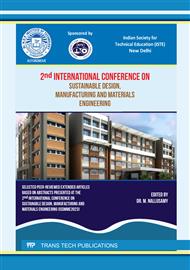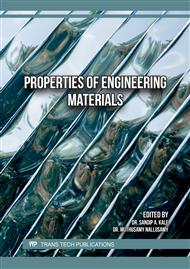[1]
Ashish Babarao Gawande, Yash Suneel Khandekar and Ojas Pravin Rahate, Applicability of Concrete Treated with Self-Healing Bacterial Agents. International Journal of Civil Engineering and Technology, 7(5), (2016), p.275–283
Google Scholar
[2]
Abhishek Thakur, Akshay Phogat and Khushpreet Singh, Bacterial Concrete and Effect of Different Bacteria on the Strength and Water Absorption Characteristics of Concrete: A Review. International Journal of Civil Engineering and Technology, 7(5), (2016), pp.43-56.
Google Scholar
[3]
B.Vijaya and S.Senthil Selvan, Corrosion effects on the flexural strength behavior of concrete containing manufactured sand, ARPN Journal of Engineering and Applied Sciences, vol. 13, no. 5, (2018), pp.1972-1982.
Google Scholar
[4]
V.Srinivasa Reddy, M.V Seshagiri Rao, S.Sushma. Feasibility Study on Bacterial Concrete as an innovative self crack healing system. International Journal of Modern Trends in Engineering and Research, e-ISSNNo.:2349-9745, Volume 2, Issue 7, (July-2015) Special Issue of ICRTET'2015, 2-4 July, 2015, pp.642-647.
Google Scholar
[5]
Sakina Najmuddin Saifee, Divya Maheshbhai Lad, Jayesh Rameshbhai Juremalani. Critical appraisal on Bacterial Concrete, IJRDO-Journal Of Mechanical And Civil Engineering, ISSN: 2456-1479, Volume-1, Issue-3, (2015), pp.10-14.
Google Scholar
[6]
Mohit Goyal, P. Krishna Chaitanya, Behaviour of bacterial concrete as self healing material, International journal of emerging technology and advanced engineering,ISSN 2250-2459, volume 5, Issue 1, January (2015), pp.100-103
Google Scholar
[7]
Gosh S K,Self-healing materials; fundamentals, design strategies and applications Wiley. ISBN: 978-3-527-31829-2, (2008).
Google Scholar
[8]
P.Ghosh, S.Mandal, Development of Bio concrete material using an enrichment culture of novel thermophilic anaerobic bacteria, Indian Journal of Experimental Biology, 44(4): 336-339. (2006)
Google Scholar
[9]
Jagadeesha Kumar B G, R Prabhakara, Pushpa H. Effect Of Bacterial Calcite Precipitation On Compressive Strength Of Mortar Cube, International Journal of Engineering and Advanced Technology (IJEAT), ISSN: 2249 – 8958, Volume-2, Issue-3, (2013), pp.486-491.
Google Scholar
[10]
D.W. Muynck, K. Cox, N. Belie, W.Verstraete, Bacterial carbonate precipitation as an alternative surface treatment for concrete, Construction and Building Materials, (2008) 22: pp.875-885.
DOI: 10.1016/j.conbuildmat.2006.12.011
Google Scholar
[11]
Mallikarjuna Rao's, Kiran Kumar Poloju, Shalin Prince, Adams Joe, Ram Kishore Manchiryal, Impact of Bacillus Subtilis on strength properties of different grades of concrete, Journal of Jilin University, Vol: 41 Issue: 05-May 2022.
Google Scholar
[12]
Fadi Althoey, Osama Zaid, Mohamed M. Arbili, Rebeca Martínez-García, Ali Alhamami, Hammad Ahmed Shah, Ahmed.M. Yosri, Physical, strength, durability and microstructural analysis of self-healing concrete: A systematic review, Case Studies in construction Materials, Vol 18, July 2023.
DOI: 10.1016/j.cscm.2022.e01730
Google Scholar



